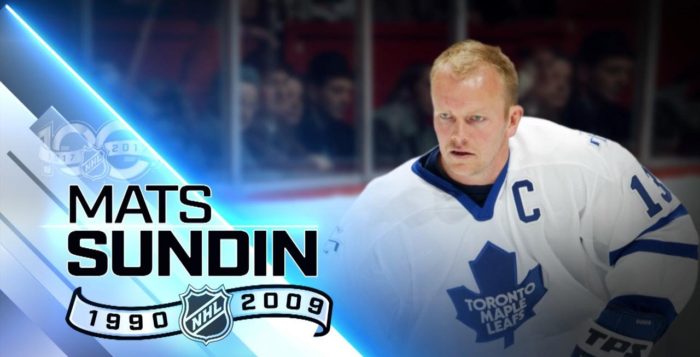This Day in Hockey History – June 17, 1989 – Swede Sundin Selected
The Quebec Nordiques had first pick out of the 1989 NHL Entry Draft. They had only had their eye on one player for the two months leading up to June 17. When the moment came, they picked Mats Sundin of Sweden, making him the first European ever selected first overall. Prior to that, the earliest a Swede had been drafted was seventh overall.
In 1989, the Mets Sports Center in Bloomington, Minnesota hosted the entry draft. Until that point, Montreal had hosted all of the drafts but for 1985 (held in Toronto) and 1987 (held in Detroit). Among the 2,500 spectators was a group of fans who had traveled there from Quebec to hang a Nordiques banner and cheer as Sundin’s name was announced.
Most expected Sundin to be drafted in the top two. Having gone to Sweden to watch him play, scouts liked the 18-year-old forward’s “size, speed and skills.” He was a “finesse player” with “tremendous skills, [who] skates well and is a natural scorer.” The Nordiques’ chief scout, Pierre Gauthier, said, “He was the best talent available. We think this guy’s got the exceptional hands and great talent. It gives us a chance to have a very good hockey player down the line.” Gauthier greeted Sundin on stage with a Nordiques jersey and ball cap. Little did Gauthier know how right he would be when he said, “He has the potential to become a superstar in the National Hockey League.”
Others expressed concerns that the Swedes tended to play five or six seasons in the NHL before returning home to Sweden. Meanwhile, Swedish players preferred Nikla Andersson, whom the Nordiques chose in the fourth round. In addition, Sundin had two years remaining on his contract with Djurgardens IF Stockholm and seven to eleven months of military service to complete before he could skate for the Nordiques. Gauthier said they were planning to try to get the military service out of the way as soon as possible and then perhaps buy out Sundin’s hockey contract.
Although he had spoken with the Nordiques the day before, Sundin admitted, “I still had no idea if they would pick me. I was really nervous.” He was pleasantly surprised to be chosen first. Of his future home, Quebec City, Sundin joked, “I know it’s a nice town and it has a lot of girls. That’s about it.” He then stuttered through saying hello in French. Taking in the big picture, Sundin remarked, “I think this is a great moment for European hockey.”
As it turned out, Sundin was able to skate in Quebec beginning in 1990, scoring 59 points as a rookie. After four seasons, Quebec traded him to the Toronto Maple Leafs in June 1994. His first season in Toronto would be his former team’s last in Quebec before relocating to Colorado.
Sundin skated with the Maple Leafs for 13 seasons, and for all but one, Sundin led the team’s scoring. To this day, his 420 goals and 987 points remain Toronto records. In fact, his career totals, 564 goals and 1,349 points, remain the most of any Swedish player in the NHL. He was the first Swede to reach 500 goals and 1,000 points. Sundin also served as Toronto’s captain for over a decade, between 1997 and 2008. He was the first European to lead the Maple Leafs. In honor of his contributions to the team, Legends Row, outside Air Canada Centre in Toronto, features his statue. Toronto voted him their fifth-best player of all time and retired his No. 13.
In December 2008, Sundin signed with the Vancouver Canucks, which basically meant that his career moved westward across the entire country of Canada. After this last hurrah, he officially announced his retirement in September 2009, about 20 years and 2 months from when he was drafted.
Meanwhile, Sundin had continued to represent Sweden. He helped them win the World Championship in 1991, 1992, and 1998. He also skated for his country at the 1998, 2002, and 2006 Olympics. For the last of these, he captained the gold-medal team and assisted on the game-winning goal.
Sundin was inducted into the Hockey Hall of Fame in Toronto in 2012. Though he would have like to have won a Stanley Cup championship, he said, “It feels like I’ve experienced so much more than I could ever have imagined.”
Additional Sources:
- Mike Commito, Hockey 365: Daily Stories from the Ice(Toronto: Dundurn, 2018), kindle edition.
- “NHL Draft,” Minneapolis Star Tribune, 18 June 1989, pp. 4C-6C.
- “Quebec drafts Swede first overall” and “Habs surprise scouts by drafting Vallis,” Montreal Gazette, 18 June 1989, p. C4.
- https://www.nhl.com/news/mats-sundin-100-greatest-nhl-hockey-players/c-285390234?tid=283865022














